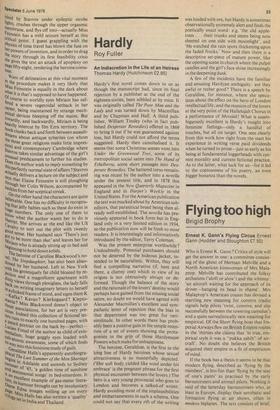Flying too high
Brigid Brophy
Ernest K. Gann's Flying Circus Ernest Gann (Hodder and Stoughton £7.50) Who is Ernest K. Gann ? Critics of style will get the answer in one: a committee consisting of the ghost of Herman Melville and a North American kinswoman of Mrs Malaprop. Melville has contributed the folksy archaisms ('aloft or alow') and the whimsy : 'an aircraft waiting for the approach of its driver—hanging its head in shame'. Mrs Malaprop's American cousin has devised a startling new meaning for connive (radio signals help pilots 'twist, connive, and slip successfully between the towering cumulus') and a quite surrealistically new meaning for empirical. Of the Short flying boat that Imperial Airways flew on British Empire routes in the 'thirties she claims that 'in true, empirical style it was a "pukka sahib" of aircraft'. No doubt she believes the British acquired their empire in a fit of empiricism of mind.
If the book has a thesis it seems to be that modern flying, described as 'flying by the numbers', is less fun than 'flying by the seat of one's pants' as practised by the early barnstormers and airmail pilots. Nothing is said of the latterday barnstormers who, at least in Europe, display their acrobatic and formation flying at air shows, often in modern biplanes. The text consists of brief,
virtually unconnected snatches about some of the machines and pilots of the Art Deco decades. Some bits are expressed as straight reminiscence, others as reconstructions— that is, they are couched in the present tense and throw in items of period scene-setting like 'Enter ex-corporal Adolf Hitler (Iron Cross)'.
Determined aviation fanatics may extract a little gossip. Pilots of the Boeing Stratocruiser carried hats and raincoats because, when the aircraft descended, so did the condensed breath of the passengers from the glass roof of the flight deck. In 1943 BOAC was regularly flying an unarmed Mosquito between Scotland and Sweden, to deliver VIPs and collect ball bearings. To compensate for power torque, the Piaggio Royal Gulls had one wing shorter than the other. The bulk of the text, however, is sheerest and merest scraping of the cracker barrel. Presumably it's an example of writing by the seat of one's pants. By contrast, the illustrations, which have none of the charm of the machines they depict, are ugly enough to be an example of painting by numbers.
Though issued here by a British publisher, the book is not merely type-set but printed in the USA. Its spelling is North American, and so is the fussy and old-fashioned look of the pages. That anyone bothered to import it argues a sad miscalculation of the market. We aviation fanatics won't buy just anything that can be put on sale in a tent at Biggin Hill on Battle of Britain Day. We have our standards and even our sophistications. (A publisher with a sensitive seat to his pants would note that those solid, silvercoloured, metal models, on spikes, of Art Deco aeroplanes are now the rage of the King's Road.) From a flying circus we expect, at the least, High Camp. For £7.50 we should be entitled to expect the serious technical and social history of civil aviation, between 1920 and the arrival of the jets, that will make not a fortune but a decent success for the first publisher with the enterprise to pay a big enough advance to get the documentation done properly and, more daringly and eccentrically yet, to commission an actual writer. The illustrations, by the way. v. ill he from cigarette cards of the period.



































 Previous page
Previous page